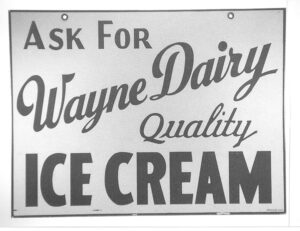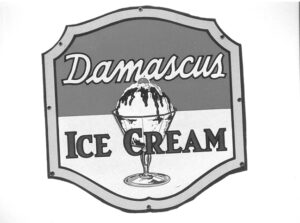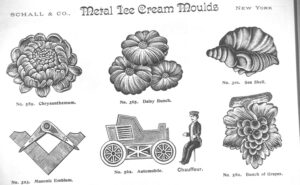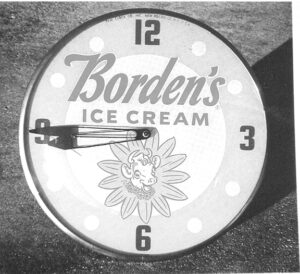 By Robert Reed
By Robert Reed I scream. You scream. We all scream for ice cream.
—popular 20th century phrase.
George Washington may well have been the nation’s first celebrity consumer of ice cream back in the 18th century.
The “Father of Our Country” was known to have purchased a “cream machine for ice” as early as 1784. An inventory of his estate in the early 1800s noted two “Pewter Ice Cream Pots” in the upstairs kitchen of Washington’s Mt. Vernon home.
Colonial newspapers on occasion advertised commercially made ice cream at shops in cities like Boston and New York. Most early ice cream was made at home, however, using pewter ware similar to that owned by Washington.
The much more convenient hand-cranked ice cream freezer was patented in May of 1848, and by the end of the Civil War such “improved ice cream freezers” were found in many American homes.
As the extensive development and manufacture of ice boxes progressed in the middle Victorian era, thus did the demand for the handy ice cream freezer.
 Victorians could now readily avail themselves of the stored ice needed to freeze the contents of milk, sugar, eggs and fresh cream. It took lots of cranking, but was well worth it when the dessert was served.
Victorians could now readily avail themselves of the stored ice needed to freeze the contents of milk, sugar, eggs and fresh cream. It took lots of cranking, but was well worth it when the dessert was served. By the 1880s and 1890s the ice cream freezer was a significant item in leading department stores and in catalogs. In 1884 one catalog featured selections from the American Machine Company.
American Machine produced both single- and double-action crank freezers, but they also offered models which claimed to take less effort.
“The growing demand for small size Freezers with Fly Wheels had prompted us to add them to our Wonder line on all sizes,” they noted. “The labor of freezing the cream is so greatly lessened by the addition of the Fly Wheel that anyone who uses one once will never again be satisfied with a crank Freezer.”
The Triple Motion White Mountain Freezer offered still another innovation, “when the cream is all evenly frozen and mixed, the dasher can be removed, and the can may be revolved without it, until the cream is sufficiently solid.”
Right along with the freezers, late 19th century customers could purchase ice cream dishing spoons too. Square end spoons, pointed end spoons, and round bowl spoons were sold. They ranged in length from 12 to 18 inches.
 Still another popular feature of making delightful ice cream at home was the amazing array of molds. The ice cream could be pushed and shaped into all matter of images from cupid and Mother Goose to a rocking horse or George Washington himself. By the late 19th century even a battleship mold was available for preparing ice cream in a big way—it held two quarts.
Still another popular feature of making delightful ice cream at home was the amazing array of molds. The ice cream could be pushed and shaped into all matter of images from cupid and Mother Goose to a rocking horse or George Washington himself. By the late 19th century even a battleship mold was available for preparing ice cream in a big way—it held two quarts. Certainly some of the mostly pewter molds were used commercially by merchants of the late 1800s and early 1900s, but the vast majority were marketed for private at-home use. Experts today however warn that while the ice cream molds of the past are very collectible, they should be used only for display. Because of the lead content in the early models it is suggested they not be used directly with food.
Ice cream was said to have been a tasty treat for those who strolled the grounds at the 1904 Louisiana Purchase Exposition in St. Louis. Some accounts credit the makeshift use of the layers of a ice cream sandwich with the first ice cream cone.
Booklets like the Snow Ice Cream Makers Guide in 1911 and the Ice Cream Maker’s Formulary and Price List the following year with among the many provided to an eager public anxious to produce their own. At the same time commercial sites began offering ice cream on a more regular basis, often served on store advertising trays.
 During the 1920s there was a great profusion of ice cream brands for store purchases. The Carnation Milk Company offered Damascus Ice Cream to be prepared and marketed locally. The vast majority of the commercial ice cream however came from local dairy firms which offered it as a “side dish.” Calendars, pinback buttons, and other premiums frequently bore the names of Chase’s Ice Cream, Hood’s Ice Cream, the Hoffman Willis Ice Cream Company, or Walker’s Celebrated Ice Cream.
During the 1920s there was a great profusion of ice cream brands for store purchases. The Carnation Milk Company offered Damascus Ice Cream to be prepared and marketed locally. The vast majority of the commercial ice cream however came from local dairy firms which offered it as a “side dish.” Calendars, pinback buttons, and other premiums frequently bore the names of Chase’s Ice Cream, Hood’s Ice Cream, the Hoffman Willis Ice Cream Company, or Walker’s Celebrated Ice Cream.Meanwhile the 1927 Sears and Roebuck catalog offered the ever-popular ice cream freezer, along with pressed glass plain footed sherbet glasses “for sundaes, sherbets, and ice cream.”
Commercial manufacturers got around to National Ice Cream Week by the 1930s. Hendler’s Ice Cream handed out brass rests for ice cream scoops, Puritan Dairy Ice cream issued toy whistles, and signs from Hand-D Sun-D Ice Cream proudly proclaimed the positive aspects of their “new” ice cream bars.
As the 1930s drew to close the Howard Johnson’s restaurant began offering what would ultimately become 28 different flavors of ice cream, and market experts determined that even in the economic downturn Americans consumed nearly three gallons of ice cream per person each year.
The Encyclopedia of Popular Culture documents that during the dark days of World War II ice cream was the one food that K-rationed soldiers longed for the most, “because it was such a symbol of happy times.”
In 1949, hoping to encourage buying of commercial ice cream, Sealtest published and distributed a vivid booklet of recipes entitled “New Ways With Ice Cream.” It turned out to be most timely for the approaching decade.
More highly developed processing as well as more refined refrigeration allowed a growing number of retail outlets to stock ice cream during the 1950s. Brands like Borden’s, Country Club and Sealtest produced ice cream in very attractive and colorful packages which in turn attracted more consumers. Valley Farm went as far as putting a picture of popular singer Bing Crosby on the packages. Many commercial ice cream manufacturers moved to brightly colored advertisements in leading magazines during that decade. Sealtest also went to the relatively new medium of television to promote its product. Eventually Sealtest sponsored one of TV’s most popular programs, “The Kukla, Fran and Ollie Show” on NBC.
While sponsoring the “Kukla, Fran and Ollie Show,” Sealtest launched the Kukla-Ollie Spoons premium. Those that sent in 50 c ents and the trademark symbol from a carton of Sealtest ice cream could select either the Kukla set or the Ollie set. Each set had a portrait head of the selected character. Each set of three spoons were of Wallace silverplate. Today sources like “Hake’s Price Guide to Character Toys” lists them as rare.
One of the most famous ice cream wrappers of the 20th century appeared in the 1960s from some other recording stars, the Beatles. Their image appeared on the Beatle Krunch Coated Ice Cream bar from the Country Club Ice Cream Company. Collectors soon sought them out as single wrappers or in full sheets.
Elsewhere during that decade Bryer’s Ice Cream celebrated their 90th anniversary with a host of premiums, but the newly founded Danish-style, but American-produced, Haagen-Dazs dominated the marketplace.
As an official of Haagen-Dazs concluded during its promotional campaign, “Ice cream is the one luxury everyone can afford.”















Follow Us